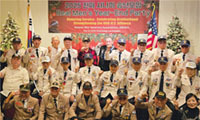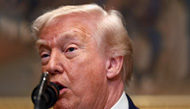▶ By Joseph C. S. Yi
With the 50th anniversary of the beginning of the Korean War approaching, South Korea’s President Kim, Dae-jung and North Korea’s Leader Kim, Jong-il met in Pyongyang, North Korea, to begin a historical three day summit.
High ranking officials, on both sides of the 38th parallel, have cautioned against unrealistically high expectations. Still, as a Korean (Korea-born, Korean –American), I am hopeful of the eventual achievement of a unified Korea; the only questions are how long will it take and what should be the intermediate steps.
President and Chairman of the Board of the Korea Society stated that, the stage for the Summit was established by President Kim’s inauguration speech on February 25, 1998. The speech laid out the three principles that comprised his “Sunshine Policy” of engagement with North Korea. They Are:
(1). No toleration of any sort of military provocation, from both sides;
(2). No efforts to undermine or absorb North Korea, by South Korea; and
(3). Re-establish the agenda that was embodied in the South-North Agreement
signed in December, 1991.
In the intervening two years, much has been done to implement the Sunshine Policy principles to gain the support of other countries, not only in Asia but through the world, by active diplomacy.
Major accomplishments of President Kim’s first two years in office has been the establishment of diplomatic relations with Japan, China and Russia, and the continuation of the long standing positive relationship with the United States. These successes strengthened South Korea’s hand in dealing with North Korea.
To help the situation further, in November 1998, the State Department of the United States together with the Council of Foreign Relations, conducted an independent study of America’s policy toward North Korea.
The Study Report, issued on October 12, 1999, stated that:
(1). No U. S. Policy can succeed unless it is coordinated with ROK policies; and
(2). The United States’ policies must deal with North Korea as it is, not as
America wishes it to be (North Korea shows no sign of collapse in the near future).
These conclusions, together with the Sunshine Policy, form the blue print for success in achieving the reunification of Korea. We will need, in addition, lots of patience and determination.
In addition to this blue print for reunification, the matter of costs must be addressed. The estimates of costs range from a low of $200 billions by an American economist, to over $3 trillions by a Korean economist. In between, among other estimates, is the $610 billions by the Germans with a comment that these costs would place a tremendous and unrealistic burden on South Korea.
We look upon the German reunification as a model of our situation, but when we look closely at the details, I think we would come to the conclusion that it is not a good model.
Whereas the west-east German population ratio was 4 to 1, the south-north Korean population ratio is 2 to 1. Also, whereas the west-east German income ratio was 2 to 1, the south-north Korean income ratio is 13 to 1. These statistics, at the present time, make South Korea’s burden almost impossible to bear, and unrealistic to plunge head on for an immediate total reunification.
I have been a member of the Advisory Council on Democratic & Peaceful Unification of Korea, in the Chicago Region, since 1991. It took many years, but the Unification Council has finally emerged into a positive force for reunification, thanks to the enthusiasm and leadership of President Kim.
In my second year as a member of the Council, I was appointed the Chairman of the Public Relationship Committee. Although the Council had been in existence for over a quarter century, I could not find any material in the English language. I wondered how I could convey the Council’s official message to the second generation Korean Americans and to the Americans, without any officially sanctioned material.
I asked about the existence of any official English text regarding the unification policies of the Republic of Korea. Communicating back and forth with the ROK government in Seoul, We found out that there weren’t any.
Then I made a formal proposal that, as a part of my responsibilities as the Chairman of the Public Relations Committee, our Committee would produce the English material for dissemination to the Korean, as well as the American, public in the United States. The Ministry of Unification of the Republic of Korea told us that we must not do it. They gave us some reasons, unsatisfactory to me, as to why we cannot. In fact, one of the officers in the Chicago Chapter of the Unification Council called me, at home one night, and insisted that we must not continue to pursue this idea.
The environment for unification has changed a great deal since those earlier years. I am a firm believer that strong leadership, especially in a culture like ours, is vital to the success of any and all endeavors.
As a result of world-wide events and preparations made by President Kim, the June Summit brought about the following 5-point South-North Joint Declaration:
(1). The question of unification shall be solved by the joint efforts of the Korean people;
(2). The Two Koreas will work toward unification based on the recognition of the differences in the forms of government envisioned by the two Koreas;
(3). Reunions of families, separated by the War, will take place around August 15;
(4). Economic prosperity, for the North, will be pursued by stepping up economic cooperation. To reinforce these efforts, there shall also be widening
exchanges of cultural, social, sports, health and environmental activities; and
(5). Unlike in the past, when commitments were not honored, the Joint
Declaration included provisions for follow-up South-North ministerial level
Dialogue to implement the Agreement.
There appears to be progress. The fact that the two leaders actually met is something that we did dare to hope for not too long ago, and we did have the reunions of families, and the plans for the Seoul visit, by Leader Kim, seem well under way, and there have been meetings of high level officials from both sides, and there are plans being made for linking the two Koreas by rail (between Seoul and KaeSong and ultimately to Pyongyang), and the construction of a highway across the DMZ.
The opening ceremonies of the Olympics in Sidney gave us another reason for optimism. It did my old heart wonders seeing the athletes of the divided Koreas marching together, hand in hand, before a world stage.
The Germans, combining their medal totals (57), placed fifth in the world standings. If Koreas had combined their totals (28 plus 4), we would have placed eighth; quite an accomplishment in the presence of such perennial powers as England, Japan, etc.
These are auspicious beginnings but we must be cautious, and we must be patient. After all, it took the Germans nine (9) summit meetings over a period of twenty (20) years to accomplish the reunification, and that country did not go through a devastating civil war as we did.
It is troublesome to note, a recent internet interview showed that the ROK young people were not knowledgeable of our historic relationship with North Korea – that we are one nation. This feeling seemed most prevalent among children of the people that are financially well off.
September 6, 2000 issue of the Ewha Voice reported that, according to a survey carried out in March by the Advisory Council on Democratic & Peaceful Unification, only 51% of the 1879 university students who participated in the survey said they were interested in unification, and 53% said it would be nice to unify with the North but that it is not an obligation. Most university students, being the post-war generation, do not have a positive attitude toward inter-Korea relations.
It is fair, I think, to admit that the attitudes of the young people are not totally their fault. We adults, and the environment we created, must take a lion’s share of the blame. Our generation has been trying, overtime, to develop a better world for our children, perhaps without the conscience or the wisdom to know what is better.
We became self-impressed with our financial successes and lost sight of what is really important; set of moral values, societal order and a sense of history. As a result, we reared children who are selfish, who have adopted life styles that should not have tolerated but did nothing about.
One of the benefits of the Summit is that it has awakened an interest among the young people of South Korea, about North Korea; they are flocking to book stores in search of books about North Korea and its reclusive Leader.
In the October, 2000 issue of the Reader’s Digest, it reports that the Pyongyang regime has for years played a clever, largely successful game to extract massive aid from around the world, especially from the United State and South Korea. It warns, before we give them the keys to our treasury and other resources, we must ask the question, are North Korea’s current activities really sincere and their intentions really peaceful? If so, there are a number of things they must do, not just talk a good gam
North Korea must withdraw its huge army away from the South Korean border (and, of course, South Korea must also withdraw its forces away from the North Korean borders), cease development of weapons of mass destruction including nuclear bombs and ballistic missiles, honor its treaty obligations with the Atomic Energy Agency, and free its own people from the shut down of outside news.
It was not long ago that, when the international community talked about imposing drastic sanctions on North Korea if it did not comply with the treaty agreement, it replied that “sanctions mean war, and war means South Korea’s capitol city of Seoul would be engulfed in a sea of fire.”
In essence, North Korea has wrung money and resources (fuel, food, technical assistance, etc.) from the world community. Amazingly, North Korea is one of the largest U. S. aid recipient in Asia – even while it remains on the countries listed, by the U. S. State Department, as a sponsor of terrorism.
Henry Sokolski, the Executive Director of the Non-Proliferation Policy Center in Washington, D. C., stated recently that North Korea is more dangerous today than it was six years ago.
In the face of such negative opinions, South Koreans and the world can only hope that the peace summit, this spring, was for real, and stay vigilant. We must constantly keep in mind the alternative to reunification – the devastation of the Korean War and all its aftermaths.
We must look to the world for help, mostly from the United States, Japan, China and even Russia, in this reunification effort. But importantly, we must LOOK TO OURSELVES to achieve the most important task that we have the privilege to resolve.
Our DESIRE is the most important ingredient for reunification. Do we have it? Do we have it in abundance? Can we, will we, make the sacrifices necessary to achieve the reunification of our beloved Korea?
Joseph Yi came to America in 1940, at the age of 10, and has lived basically in the Chicago Metropolitan Area. Although Mr. Yi’s professional life was in the mainstream society, he has actively participated in the voluntary social services for the Chicago Korean community.
스마터리빙
more [ 건강]
[ 건강]이제 혈관 건강도 챙기자!
[현대해운]우리 눈에 보이지 않기 때문에 혈관 건강을 챙기는 것은 결코 쉽지 않은데요. 여러분은 혈관 건강을 유지하기 위해 어떤 노력을 하시나요?
 [ 건강]
[ 건강]내 몸이 건강해지는 과일궁합
 [ 라이프]
[ 라이프]벌레야 물럿거라! 천연 해충제 만들기
 [ 건강]
[ 건강]혈압 낮추는데 좋은 식품
[현대해운]혈관 건강은 주로 노화가 진행되면서 지켜야 할 문제라고 인식되어 왔습니다. 최근 생활 패턴과 식생활의 변화로 혈관의 노화 진행이 빨라지고
사람·사람들
more
‘러브인뮤직’ 2025 성탄 음악회 성료
러브인뮤직은 지난 20일 LA 동양선교교회(담임 김지훈 목사)에서 가진 2025 성탄 작은 음악회를 끝으로 각 지역 봉사처별 올해 활동을 마무…

한인 향군 단체들 ‘진짜사나이’ 송년 행사
6·25 참전유공자회(회장 이재학)와 육군협회(회장 최만규)가 공동 주최한 2025 ‘진짜사나이’ 송년모임이 지난 19일 LA 용궁식당에서 한…
“취미생활로 다진 친목… 선후배들과 만든 모교사랑…
사진러브한인 사진 동호회 사진러브(회장 크리스 고)는 13일 용수산에서 송년모임을 갖고 한 해를 마무리하는 뜻깊은 시간을 가졌다. 이날 모임에…
[홀인원] 이상원 박사
일반외과 전문의 이상원(왼쪽) 박사가 지난 9일 뉴포트비치 소재 골프장 9번 홀(152야드)에서 레스큐 클럽으로 친 샷이 그대로 홀에 빨려 들…
[송년행사 게시판] 재미시인협회
재미시인협회(회장 지성심)는 오는 20일 오후 4시 가든스윗호텔에서 한 해를 마무리하며 동인지 ‘외지’ 제35집 출판 기념회와 ‘제23회 재미…
많이 본 기사
- ICE 홈디포 급습단속에 한인 체포 2
- 트럼프, 그린란드 특사 임명…덴마크, “영토 존중” 반발
- CBS, ‘이민자 추방’ 관련 보도 취소… ‘트럼프 눈치보기’ 비판
- 한인 박찬영씨 교통시비 총격 사망...타코마중앙장로교회 40대 장로, 19일 레이시 도로서 참변
- 트럼프 친구 사업가의 골프장, 세계 분쟁종식협상 무대돼
- ‘결혼’ 신민아♥김우빈, 영화 한 장면 같네..본식 사진 공개
- ‘경악’ 오타니 골드카드 300만 달러에 낙찰! 슈퍼스타 위엄, KBO 최고연봉도 넘었다
- 기안84, 알고 보니 엘리트 집안? “외할아버지= 부산대 법대 출신”
- “AI 아님” 이병헌♥이민정, 부부가 나란히.. ‘미담’ 터졌다
- 경찰, ‘여론조사비 대납의혹’ 이준석 무혐의… “추측성 진술뿐”
- 희대의 박나래 사태, 쌍방 고소전으로..법적 절차 본격화
- 여야, ‘통일교특검’ 각자 발의후 협의키로…특검후보 추천 쟁점
- 연말 ‘로드레이지’ 비극… 한인 총격 피살
- ‘장기 부상’ 김민재마저 쓰러졌다, 이미 이강인도 ‘최소 몇 주’ 결장 불가피... 韓 국가대표 연속 비보
- 박보검 미담 또 추가..이연복도 인정한 ‘다 가진 남자’
- 성탄 연휴 폭우 ‘비상’ 주중 최대 6인치 온다
- 상공회의소 전현직 다 모였다...전현직 회장단 송년모임 통해 화합과 연대 다짐
- 한국계 NASA 우주비행사 조니 김 … 1
- 240만달러 투자사기로 호화생활 탕진...전 이스트사이드 부동산 에이전트 투자사기 유죄 평결
- 운전중 시비 끝에 총 맞아 40대한인 사망
- 17년차에 17개 수상으로 증명했다..국민 여동생, 국민 가수, ‘국민 배우’까지 ‘아이유 천하’
- “동해(East Sea), 기억하고 함께 부르자”...페더럴웨이 통합한국학교, 시애틀총영사관과 ‘동해병기 캠페인’
- 트럼프행정부, 동부해안 5개 대형해상풍력단지에 해역임대 중단
- 트럼프, 건강보험사들에 “보험료 내려… 1
- 시애틀한국교육원, 개원 첫해 ‘눈부신 성과’...이용욱 원장 “26년만 재개원, 교육행정 중심으로 자리잡아”
- 시택공항 연말 할리데이시즌 이용객 3% 늘듯...12월 18일부터 1월 4일까지 250만명 예상…여름 성수기보다는 한산
- 맥도널드 주차장서 싸움 끝 총격
- 애난데일 인근 I-495에서 28중 추돌사고, 8명 부상
- ‘거액 탈세·통관 사기’ 한인 통관브로커 중형
- 미 자동차 업계… 전기차 접고 내연차로 회귀
- 올해 메릴랜드 교도소 수감자 약 70명 숨져
- 말살되고 있는 유럽의 성탄절 전통, … 1
- ‘1세대 연극 스타’ 윤석화 뇌종양 투병 69세로 별세
- 관세로 준다던 미군 보너스 알고보니 ‘주택보조금’ 예산
- 미주한인 이산가족 북한 고향 길 열려
- 한국 화장품 1+1 등 성탄 특별세일
- 로드아일랜드 디자인 학교 전액 장학생 합격
- JGL 건설회사 송년회… 장학금 전달
- “남의 묘비에 이름 새기는 것 같다”
- 구글 알파벳 “데이터센터 확장”…인터섹트 47억5천만달러에 인수
- 파워볼 로토 열풍 지속 오늘 잭팟 16억 달러로
- 한인 최초 NASA 우주비행사 조니 김… “우주서 김치·밥 그리웠다”
- 트럼프, 전 정부 임명 대사급 외교관 30여명 소환
- 사사세 워싱턴 송년회
- ‘트럼프 골드 카드’ 1300명 이상 신청
- 냉장고 문짝 1초 만에 조립… ‘다크 팩토리’ 성큼
- 뉴욕상춘회, 송년회
- 외로운 이웃들
- 송미숙 뉴저지한인회장 당선자 후원의 밤
- 우리어덜트데이케어, 연말파티
1/5지식톡

-
 미 육군 사관학교 West Poin…
0
미 육군 사관학교 West Poin…
0https://youtu.be/SxD8cEhNV6Q연락처:wpkapca@gmail.comJohn Choi: 714-716-6414West Point 합격증을 받으셨나요?미 육군사관학교 West Point 학부모 모…
-
 ☝️해외에서도 가능한 한국어 선생님…
0
☝️해외에서도 가능한 한국어 선생님…
0이 영상 하나면 충분합니다!♥️상담신청문의♥️☝️ 문의 폭주로 '선착순 상담'만 진행합니다.☎️ : 02-6213-9094✨카카오톡ID : @GOODEDU77 (@골뱅이 꼭 붙여주셔야합니다…
-
 테슬라 자동차 시트커버 장착
0
테슬라 자동차 시트커버 장착
0테슬라 시트커버, 사놓고 아직 못 씌우셨죠?장착이 생각보다 쉽지 않습니다.20년 경력 전문가에게 맡기세요 — 깔끔하고 딱 맞게 장착해드립니다!장착비용:앞좌석: $40뒷좌석: $60앞·뒷좌석 …
-
 식당용 부탄가스
0
식당용 부탄가스
0식당용 부탄가스 홀세일 합니다 로스앤젤레스 다운타운 픽업 가능 안녕 하세요?강아지 & 고양이 모든 애완동물 / 반려동물 식품 & 모든 애완동물/반려동물 관련 제품들 전문적으로 홀세일/취급하는 회사 입니다 100% …
-
 ACSL 국제 컴퓨터 과학 대회, …
0
ACSL 국제 컴퓨터 과학 대회, …
0웹사이트 : www.eduspot.co.kr 카카오톡 상담하기 : https://pf.kakao.com/_BEQWxb블로그 : https://blog.naver.com/eduspotmain안녕하세요, 에듀스팟입니다…
케이타운 1번가
오피니언
 옥세철 논설위원
옥세철 논설위원말살되고 있는 유럽의 성탄절 전통, 그 원인은…

외로운 이웃들
 조지 F·윌 워싱턴포스트 칼럼니스트
조지 F·윌 워싱턴포스트 칼럼니스트 [조지 F. 윌 칼럼] MIT에 대한 트럼프의 무분별한 공격
 전지은 수필가
전지은 수필가 ‘소명’이라 알아듣고
 최문선 / 한국일보 논설위원
최문선 / 한국일보 논설위원[지평선] 쿠팡의 “한국말 몰라요”

잇단 총격·테러 음모… 한인타운 안전 우려

2025년, 성찰과 감사의 마무리를
 김인자 시인ㆍ수필가
김인자 시인ㆍ수필가 [금요단상] AI와 동거, 그 실체
 한영일 / 서울경제 논설위원
한영일 / 서울경제 논설위원[만화경] 웰다잉 인센티브
1/3지사별 뉴스

빅애플 2025년 송년회
빅애플(대표 여주영)은 지난 19일 퀸즈 베이사이드 소재 산수갑산2 연회장에서 2025년 송년회를 열고 회원들간 화합과 친목을 도모했다. 이날…
재미 한인이산가족 상봉 길 열렸다

미주한인 이산가족 북한 고향 길 열려
“그리워하면 언젠가 만나게 되는…” 노래 가사처럼 그리워하면 다시 만날 수 있을까. 재미한인이산가족들은 그렇게 그리워하며 반세기가 넘게 기다리…
워싱턴 메트로지역 5세이하 아동인구 20년새 1.8%⇩

연말 ‘로드레이지’ 비극… 한인 총격 피살
연말을 맞아 도로 위에서 순간적으로 벌어진 운전 중 시비가 40대 한인 가장의 총격 피살 비극으로 이어졌다. 워싱턴주 레이시 경찰국과 서스턴 …
엡스타인 파일 공개 다음날 트럼프 사진 삭제…야당서 탄핵 경고

오늘 하루 이 창 열지 않음 닫기 

















































.png)


댓글 안에 당신의 성숙함도 담아 주세요.
'오늘의 한마디'는 기사에 대하여 자신의 생각을 말하고 남의 생각을 들으며 서로 다양한 의견을 나누는 공간입니다. 그러나 간혹 불건전한 내용을 올리시는 분들이 계셔서 건전한 인터넷문화 정착을 위해 아래와 같은 운영원칙을 적용합니다.
자체 모니터링을 통해 아래에 해당하는 내용이 포함된 댓글이 발견되면 예고없이 삭제 조치를 하겠습니다.
불건전한 댓글을 올리거나, 이름에 비속어 및 상대방의 불쾌감을 주는 단어를 사용, 유명인 또는 특정 일반인을 사칭하는 경우 이용에 대한 차단 제재를 받을 수 있습니다. 차단될 경우, 일주일간 댓글을 달수 없게 됩니다.
명예훼손, 개인정보 유출, 욕설 등 법률에 위반되는 댓글은 관계 법령에 의거 민형사상 처벌을 받을 수 있으니 이용에 주의를 부탁드립니다.
Close
x